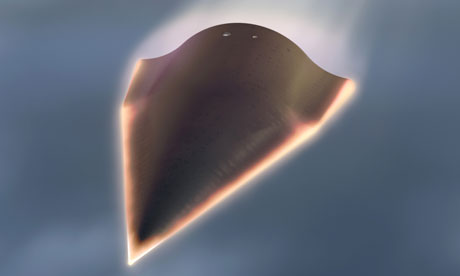
Artist’s rendition of the Falcon HTV-2, an unmanned, rocket-launched aircraft that flies at approximately 13,000 miles per hour. Photograph: AP/DARPA
By the time you finish reading this sentence, the Falcon HTV-2, the fastest plane ever built, could have flown 18 miles. It could travel from London to Sydney in less than an hour and cross the US mainland, from New York to Los Angeles, in 12 minutes.
Launched:
At 3pm BST on Thursday , the US Defence Advance Research Projects Agency launched the Falcon Hypersonic Technology Vehicle 2 on the back of a rocket from the Vandenberg Air Force Base in California. If all goes according to plan, engineers will launch the Falcon HTV-2 to the edge of space, before detaching the plane and guiding it on a hypersonic flight that will reach speeds of 13,000mph (about 20 times the speed of sound) on its return to Earth.
The plane has been tested in computer models and wind tunnels, but they can only simulate speeds up to Mach 15 (11,400mph). A real test is the only way to determine if the plane will remain flying at high speeds.
Thursday’s flight will also test the carbon composite materials designed to withstand the extreme temperatures the plane will experience on its skin and also the navigation systems that will control its trajectory as it moves at almost four miles per second.
The design and flight pattern of the plane has been tweaked since an aborted test flight in April last year. Nine minutes into that mission, which succeeded in flying for 139 seconds at Mach 22 (16,700mph), the onboard computer detected an anomaly and ordered the plane to ditch into the ocean for safety reasons.
Lost:
After separating from the rocket at the edge of space and beginning its return to Earth, the aircraft went silent during the gliding stage of the test flight, when it was due to perform a series of manoeuvres as it hurtled through the atmosphere.
Officials at the US Defence Advance Research Projects Agency (Darpa) announced they had lost communication with the speeding craft at 4.21pm BST, 36 minutes into the flight.
The plane was born from a Darpa plan called Prompt Global Strike, which sought to give military commanders the ability to strike targets anywhere in the world within an hour. Had the project worked, the Falcon HTV might have replaced intercontinental ballistic missiles.
The loss of the hypersonic aircraft is a serious setback for engineers trying to perfect the art of flying at such spectacular speeds.
Darpa only built two Falcon prototypes and has no plans to manufacture any more. This test flight was their last shot at success before the project is considered for closure.
Had the latest test flight gone to plan, the Falcon HTV-2 would have separated from its rocket high above the atmosphere and entered a steep dive before levelling out and performing a series of subtle manoeuvres to test its aerodynamic performance. At the end of the flight the plane would have rolled upside down and steered a graceful arc into the ocean.
Engineers had hoped the flight would provide crucial information on the plane’s performance, including the resilience of its carbon composite body and navigation systems supposed to keep it on course as it moved at almost four miles per second.

